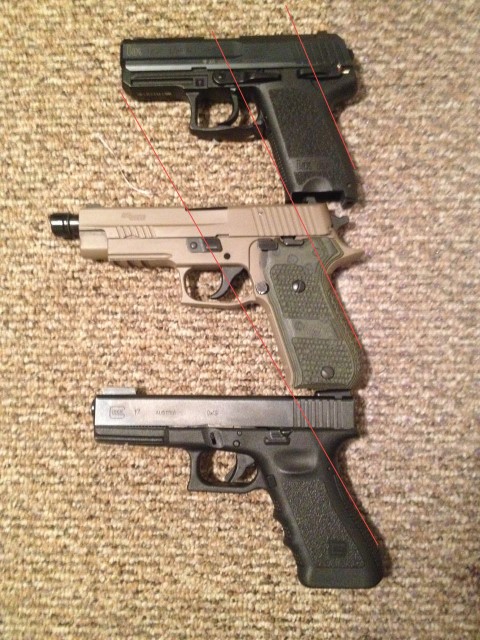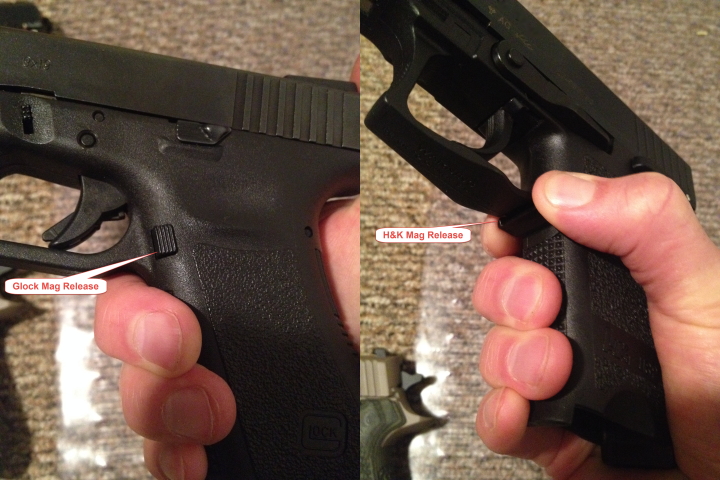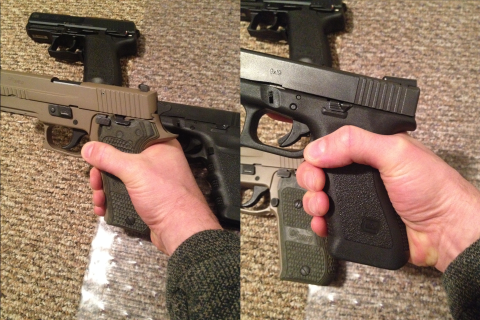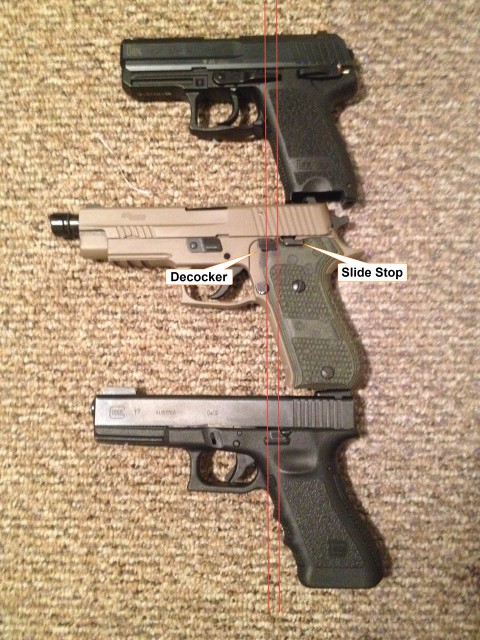Ox here…This article is going to blend an important life lesson with shooting in general and pistol shooting in particular and I’m sure it’ll ruffle some feathers. I guarantee it’ll be entertaining and educational.
There’s a school of thought in pistol training that you want to pick and use techniques that will work on several different platforms, regardless of which pistol you primarily shoot. You may not know which gun you’re going to have with you when disaster strikes and you may find yourself in a situation where you have to use a buddy’s gun or even your attacker’s gun.
It’s along the same lines of the saying that people should be a “Jack of all trades, but master of none.”
But did you know that the quote is almost ALWAYS stated wrong?
Others may have said it that way, but Benjamin Franklin said, “Jack of all trades, master of ONE” and I tend to agree with a lot of what old Ben said. More than that, there’s a big (sometimes life changing) difference, as we’ll soon see.
The “Jack of all trades” argument is one of the major arguments that people make for not using the slide stop to release the slide forward on reloads…it’s not in the same place on all pistols and if you have to pick up another gun and fight with it, you might push in the wrong spot when you’re trying to reload.
Here’s how one Marine Special Operations Command Chief Instructor put it to me: “The point of teaching a reload technique that works on all pistols, every time, without fail, is to provide the shooter with a technique that is fool proof.”
I respect the guy a ton and I get what he’s saying. He loves his guys and wants them to live through every encounter they face. And he’s using a very popular line of thinking that a lot of instructors who I have tremendous respect for agree with, but it happens to be a line of thinking that sounds good on the surface but doesn’t mesh with reality.
There’s 2 big reasons why. I’ll tell you what they are quick, and then explain them…
- Different guns are…wait for it…different. Grip angles, grip widths, safety/no safety, mag release position, mag release action, and slide stop placement are different from pistol to pistol. There is no effective reload technique that works on all pistols, every time, without fail.
- If you do go with the least-common-denominator approach and use techniques that work on most pistols, most of the time, you will never truly master the pistol you spend the most time shooting.
Let me show you a couple of pictures to illustrate what I’m talking about. What I’ve got below (from top to bottom) are an H&K USPc, a Sig P220, and a Glock 17. In the first picture, I highlight grip angles.

As you can see, the grip angles are all slightly different. You can also see from this picture that the H&K has an external safety that you may or may not need to disengage.

As shown above, the mag release is in a different position and takes a completely different movement on the H&K than on the Sig or the Glock.

Even though the mag release is in relatively the same position on the Sig and Glock, the grip is enough different that I, personally, can depress the mag release with my thumb on the Glock without moving the gun in my hand but have to rotate the Sig to hit the mag release.

Want to use the slide stop method on a gun you pick up? Well, if you practice with the Glock, your trained movement will carry over to the H&K, but, as shown above, you’ll just be hitting the decocker on the Sig.
So what’s the answer?
Fortunately, we have a well proven model to follow. It follows Ben Franklin’s sage advice and it happens to be the model that every law enforcement agency, military branch, and military unit that I know of uses for carbines:
- Master YOUR gun.
- Be familiar with as many other guns as possible.
- Master other guns.
For you Marines, “Full Metal Jacket” fans, and military history buffs, you’re probably reminded of the poem from Major General William H. Rupertus (USMC, Retired) written following the Pearl Harbor attacks. I’ll paraphrase…
“This is my rifle. There are many like it, but this one is mine.
…I must master it as I master my life.
…Thus, I will learn it as a brother. I will learn its weaknesses, its strength, its parts, its accessories, its sights and its barrel.”
When a military or law enforcement school is teaching students to shoot a rifle, they master one platform before moving on. When they’re learning how to manipulate the M4/AR15, they focus on the controls on that particular platform. They don’t teach universal techniques that also work on the AK47, Tavor, FN-FAL, etc. They master the platform that they’re going into battle with, get familiar with other weapons that they’re likely to encounter, and master those weapons as time permits.
It’s a proven model for carbines and it works for pistols as well.
So, what’s that mean?
I want to suggest a couple of things to you that you can take or leave.
First, until you have achieved the level of mastery that you want with a single pistol, try to focus all of your practice time on that one single pistol. There are slight differences, but I’d consider sub-compact, compact, and full size versions of the same pistol (Glock 17, 19, & 26) as “one pistol” and I’d also consider different calibers of the same pistol (Glock 26 & 27) as “one pistol”.
When you jump around from gun to gun before you get the chance to master one, it keeps you from ever being as good with any gun as you could be. Focus on one and then…
Once you’ve mastered one pistol, branch out as much as you want. As the pictures demonstrate, I’m all for shooting a variety of guns when the time is right 🙂 I must admit that I did this wrong for many years. I was a good shooter, but didn’t start making huge leaps in my shooting ability until I focused on a single gun.
Second, consider learning and practicing the technique that is most effective for the gun that you’re most likely to use rather than a general technique that will work “ok” on most guns. Don’t throw out a technique that works great on your gun—the gun that you’ve got a 99+% chance of having in your hand in a high stress situation–just to have a technique that may work better 1% of the time.
With the reload in particular, I use the slide stop to release the slide any time I’m running a Glock. Any time I’m running another pistol, I rack the slide.
How’s this apply to the rest of your life?
I want to encourage you to pick out a skill that you want to master. It could be something around firearms, fire-craft, billiards, chess, singing, playing an instrument, poetry, negotiating, parenting, defusing arguments, being a great spouse, memorization, etc. Pick something that you can be passionate about and dive into with reckless abandon. Master it and keep going, but then pick something else to learn.
Why?
For one, it will make you more happy. When you focus on doing things that you love and do them often enough that you switch from having to think about them consciously to having them be an unconscious skill, your brain releases more dopamine and endorphins when you do them. Once you’re able to unconsciously perform a skill, your brain opens up, creativity flourishes, and then you start being able to do truly amazing things.
Something else that you’ll find is that you’ll master the 2nd thing that you want to master much faster than it took you to master the first. Again, this causes you to release more dopamine and endorphins and be generally more happy.
Here’s a tactical example.
One of the true pioneers and innovators in SWAT tactics told me a story about one of his guys who’d done hundreds of tactical entries in the US and overseas. They were serving a warrant on a violent offender who was known to be paranoid and armed. He entered the house and the guy was 6-8 feet from him with a 1911 in his hand, pointed at the floor. The bad guy raised the pistol and appeared to flip off the safety, but the officer didn’t fire. Instead, he crossed the room, front kicked the bad guy in the chest, took him out of the fight, cuffed him, and took him in without a shot being fired.
But how and why did he do that?
The “why” is fascinating. As the officer entered the room, he saw and processed not only the brand and model of the 1911, but also that the hammer was down and that it wasn’t able to fire, so he crossed the room, DIDN’T shoot the bad guy, and planted a foot in his chest in the time that it took the bad guy to raise the gun, flip his thumb down, and press the “dead” trigger.
How did he do it? He was so comfortable from being in past high stress situations and doing dynamic entries until he mastered them that he was completely in “the zone” and his subconscious was driving the action. The subconscious sees 10x more frames per second and is able to process 10,000-1 million times faster than the conscious mind.
And the way you get to this same point where you can experience these bursts of creative genius is by picking something you want to master and sticking with it until you do.
It doesn’t mean you can’t still be a Jack of all trades…just pick one to master.
It’ll make you happier and it might even help you earn more.
Questions? Comments? How are the controls on your gun(s) different? Any crazy/unbelievable experiences that you’ve had like the officer’s? Sound off by commenting below…
Ox out.
Ox is the co-creator of:
Tactical Firearms Training Secrets
Dry Fire Training Cards
Force Recon 30-10 Pistol
Navy SEAL Concealed Carry Masters Course
8 Comments
Don
June 2, 2015Ox,
I, like many of my fellow retired military/LEOs/Preppers have a weapon in every room of my home and others around the property. They range from NA .22mag minis to HP45s, including the carbine “saddle kits”.
Numerous reasons, including the potential availability of ammo, facilitate this process, and I’ve found I can successfully follow all the basic and most of the advanced dry fire drills using them all including the Mossberg security pump.
I run the drill using a different weapon every weekend, but stay 99% on the venerable 1911A1 my father left me. I grew up with it and easily transition between it and the Taurus 1911SS 38 Super I love but don’t live fire much because of ammo issues.
Basically validating everything you say, with an added perspective.
Will
April 24, 2015Ox, I completely agree. Another example, I was training some guys overseas and was using my issue Beretta 92. When I returned I Went to the range with my trusty 1911 and couldn’t even get the weapon off safe. I holstered my pistol and left. The next day I went an purchased a Beretta 92. I will agree not the greatest concealed carry weapon, but if I need it I know how to use it. While it is great to have several handguns, rifles and shotguns, with as little training as most of us can realistically conduct, it only makes sense to choose ONE and MASTER it!
Ox
April 27, 2015LOL…I LOVE the Beretta. It’s so good on so many levels, but I went the opposite direction and had to get rid of mine. Every single rifle, carbine, pistol, and sub-gun that I have that has a thumb safety goes from “safe” to “fire” by moving my thumb down, except the Beretta. Even with all the time I spend dry firing and live firing, I couldn’t justify having anything that had opposite controls to everything else I have. I believe you did the right thing…master one, be familiar with many, and master more as time allows.
Bill
April 24, 2015Ox, I read the article & it made me think. What I mean is that when I go to range, indoor & out, I carry four different pistol`s , 2- revolver`s & 2- Glock`s. As I don`t get out very often , this is my best way to stay sharp. What do you think? Thank`s, Bill.
Ox
April 24, 2015There’s an old (not sure how old…could be wild west or could be Col. Cooper) gunfighter saying that you don’t need to fear a man with a lot of guns, but beware the man with only one gun because he probably knows how to use it.
In an ideal world, you’d have time to master every gun you own. If that’s your world, then I bow in your general direction 🙂
Here’s how I’d break it down…
If there is no “transition” time switching between revolvers, then I’d consider them to be 1 gun. Same with the Glocks. That gets you down from 4 “guns” to 2.
Next, you’ve got to make the call about what works best for you. If you’re where you want to be with both the pistol and the revolver, then keep shooting both every time. If you’re not where you want to be, and think you have room for improvement, then I’d encourage you to focus on one platform or the other for 6 or so months and focus all of your dry fire and live fire practice on either pistol or revolver. When you’re where you want to be, then start shooting the other platform.
Another way to approach it is that one is for fight’n and one is for fun. Train and practice with the one that you carry with the intent of potentially saving your life and “play” with the one that’s for fun.
Finally, I put almost all of my time in on Glocks. (I don’t love them…I’ve just been shooting them for 16 years and they work for me.) But when I’m running long distances and want to cut weight, I’ll carry a Scandium .357 Magnum. I KNOW that I won’t be as good with that gun as with the guns that I put all of my training time in on, but I also know that a lot of the fundamentals will carry over and since I carry/shoot Glocks 99% of the time, that’s where I need to put 99% of my practice/training time.
SWIS
April 24, 2015Great article. It’s so true.
Wayne Hall
April 24, 2015If the hammer on the 1911 was down then the safety couldn’t have been engaged to begin with. How did the bad guy flick off the safety if he couldn’t even have put it on with the hammer down?
Ox
April 24, 20153 possible ways…
1. In an ideal situation, the safety on the 1911 can’t be FULLY engaged with the hammer down. With all of the brands and all of the modifications done on 1911s, it DOES happen.
2. On slightly more 1911s, the safety can be partially or fully engaged with the hammer in half-cock.
3. If you’re like me, when you’ve been running a 1911 and switch to a platform without a safety, my thumb still “disengages the safety” when I draw. I’ll change the article to reflect that, but did you have a question about firearms training, attaining mastery, or flow state?
Leave A Response To Wayne Hall Cancel reply